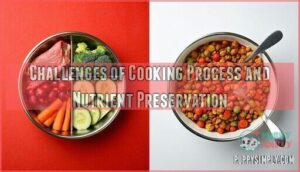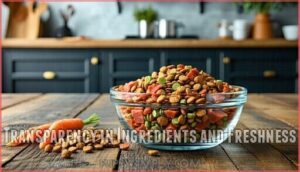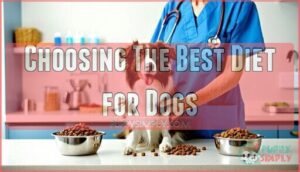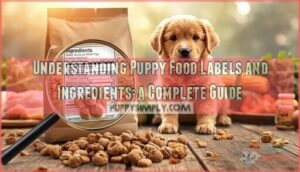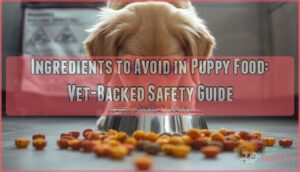This site is supported by our readers. We may earn a commission, at no cost to you, if you purchase through links.

Raw diets preserve more enzymes and nutrients but carry higher pathogen risks like Salmonella and E. coli.
Cooked food eliminates dangerous bacteria and improves digestibility, though some heat-sensitive vitamins are lost.
Both can meet AAFCO nutritional standards when properly formulated.
Your dog’s immune system, age, and health status matter—puppies and senior dogs face higher infection risks with raw diets.
Commercial raw foods undergo high-pressure pasteurization for safety, while home-prepared meals require strict handling protocols.
The "best" choice depends on your comfort with food safety measures and your pet’s specific needs.
It is essential to consider these factors to make an informed decision about your dog’s diet, ensuring you choose the option that best aligns with your pet’s specific needs and your ability to manage safety risks.
Table Of Contents
- Key Takeaways
- Raw Dog Food Basics
- Cooked Dog Food Benefits
- Raw Vs Cooked Diet Comparison
- Fresh Food Options and Considerations
- Choosing The Best Diet for Dogs
- Frequently Asked Questions (FAQs)
- Which is better for dogs, raw or cooked?
- Do vets recommend a raw diet for dogs?
- What is the healthiest way to feed a dog?
- Is a raw diet actually better for dogs?
- Can puppies eat raw or cooked food?
- How much does raw food cost monthly?
- Which diet works better for allergies?
- Can I mix raw and cooked foods?
- How do I transition between diet types?
- Conclusion
Key Takeaways
- Safety matters most – Cooked food eliminates dangerous bacteria like Salmonella and E. coli that contaminate up to 25% of raw diets, protecting both you and your dog from foodborne illness.
- Both can meet nutritional needs – Raw and cooked diets can provide complete nutrition when properly formulated to AAFCO standards, though raw requires careful supplementation and sourcing.
- Your dog’s health status determines the best choice – Puppies, senior dogs, and immunocompromised pets face higher infection risks with raw diets, making cooked food the safer option for vulnerable animals.
- Consider your lifestyle and comfort level – Raw diets demand strict food handling protocols and higher costs ($75-150 monthly), while cooked options offer convenience and easier meal planning without compromising nutrition.
Raw Dog Food Basics
Raw dog food contains primarily uncooked meat, bones, organs, and supplemental fruits and vegetables, requiring added vitamins and minerals to meet AAFCO nutritional standards.
Raw nutrition demands careful balance—your dog’s wild ancestry meets modern safety standards through proper supplementation.
You’ll find that quality sourcing becomes critical since raw ingredients carry higher contamination risks, making human-grade sourcing safer than feed-grade alternatives that may include byproducts from unhealthy animals.
Ingredients in Raw Diets
When choosing raw dog food, you’ll find muscle meat typically comprises 70-80% of the diet, with protein sources like beef, chicken, turkey, and lamb forming the foundation.
Raw meat varieties include exotic options like venison and bison. Organ meats—liver, kidney, heart—provide essential vitamins, while raw edible bones contribute calcium.
Fresh fruits and vegetables add fiber, creating nutrient balance in biologically appropriate raw foods for natural dog food nutrition. A balanced raw diet should include raw dog food ingredients to guarantee superior nutrition for dogs.
Quality and Sourcing of Ingredients
High-quality meat sourcing makes all the difference when you’re considering raw dog food for your furry friend.
The supply chain directly impacts food safety and ingredient transparency in natural dog food options.
Key sourcing considerations include:
- Organic options from certified farms that follow strict quality standards
- Minimally processed ingredients with clear traceability through the supply chain
- Whole foods diet components sourced from reputable suppliers with regular testing protocols
Human-grade facilities guarantee safer organic dog food production compared to feed-grade alternatives.
Understanding the dog food ingredients is vital for making informed decisions about your pet’s diet.
Nutritional Balance and AAFCO Guidelines
Understanding nutritional adequacy becomes straightforward when you know AAFCO standards.
These guidelines define complete and balanced nutrition through specific nutrient profiles and dietary requirements.
Raw dog food often struggles meeting AAFCO’s minimum protein, calcium-phosphorus ratios, and vitamin levels without careful formulation.
Most homemade raw diets fall short of nutritional adequacy standards, while properly formulated options require added supplements to achieve balanced diets that support your dog’s health.
The debate about raw pet food meeting standards involves examining raw food diets and their nutritional implications.
Cooked Dog Food Benefits
When you cook your dog’s food, you’re basically creating a safer meal by eliminating harmful bacteria like Salmonella and E. coli that can lurk in raw meat.
This cooking process also makes nutrients more available for your dog’s digestive system to absorb while extending the food’s shelf life in your refrigerator.
Reduced Pathogen Risks
Cooking transforms dog food safety by eliminating dangerous pathogens like salmonella, E. coli, and listeria that plague raw diets.
Studies show cooked foods contain 0-4% pathogen detection rates versus over 40% in raw options.
Cooking slashes pathogen risks from 40% in raw food to nearly zero in cooked meals.
This bacterial reduction protects both your dog and family from foodborne illness. Proper heat treatment provides effective contamination prevention, making cooked diets the safer choice for pathogen control and risk mitigation.
Improved Digestibility and Nutrient Absorption
Gently cooked meat creates digestive harmony for your dog’s system.
Unlike raw food that requires intensive digestive work, cooked protein undergoes partial breakdown during cooking, reducing strain on your pet’s digestive enzymes and improving overall gut health.
- Enhanced Nutrient Bioavailability – Cooking breaks down protein structures, making amino acids more accessible for absorption
- Improved Fiber Content Integration – Cooked vegetables provide soluble fiber that supports healthy digestion
- Better Nutrient Retention – Gentle cooking methods preserve essential vitamins while eliminating harmful pathogens
- Optimized Digestibility – Heat-treated proteins require less energy to process, improving overall nutrient absorption efficiency
Increased Shelf Life and Convenience
Cooked dog food offers significant advantages in food storage and meal planning compared to raw alternatives.
You’ll find shelf-stable, dehydrated, and air-dried options that don’t require refrigeration, making convenience foods more practical for busy pet parents.
Unlike raw dog food’s limited shelf life, cooked varieties maintain nutritional integrity longer, reducing waste and simplifying your feeding routine through reliable packaging options.
Many pet owners prefer cooked dog food for its gently cooked benefits, which provide a balanced mix of nutrients for their pets, offering significant advantages in terms of convenience and nutritional integrity, with the added benefit of reliable packaging.
Raw Vs Cooked Diet Comparison
When you’re choosing between raw and cooked dog food, you’ll need to weigh several critical factors that directly impact your pet’s health and your household’s safety.
The decision involves understanding differences in digestibility, contamination risks, and how each option fits your lifestyle and preferences, considering complete concepts that are crucial for making an informed choice.
Digestibility and Nutrient Retention
Both raw dog food and cooked diets offer unique digestibility profiles that affect your pet’s nutrient absorption.
While cooking breaks down proteins for easier digestion, raw diets preserve certain enzymes that may enhance bioavailability.
Your dog’s individual digestive health and food sensitivities ultimately determine which approach supports ideal gut balance.
| Aspect | Raw Dog Food | Cooked Dog Food |
|---|---|---|
| Digestibility | Natural enzymes aid breakdown | Heat-processed proteins easier to digest |
| Nutrient Deficiencies | Risk without proper supplementation | Better mineral bioavailability through cooking |
| Dog Dietary Needs | Preserves heat-sensitive vitamins | Enhanced protein digestibility for sensitive stomachs |
Risk of Foodborne Illness and Contamination
Foodborne illness presents a stark contrast between raw vs cooked diets.
Studies reveal up to 25% of raw dog food contains dangerous pathogens like salmonella and E. coli, while cooked options show nearly undetectable bacterial contamination levels.
| Pathogen Type | Raw Food Risk | Cooked Food Risk |
|---|---|---|
| Salmonella | 7-21% contamination | Nearly undetectable |
| Listeria | ~16% contamination | Nearly undetectable |
| E. coli/Campylobacter | Present in samples | Nearly undetectable |
| Parasites (Toxoplasma) | Documented cases | Eliminated by cooking |
Raw meat dangers extend beyond your pet—humans face zoonotic transmission through handling contaminated food or contact with infected pet saliva and feces.
The CDC links raw diets to human outbreaks, including fatalities.
Pet health hazards include asymptomatic bacterial shedding, creating invisible contamination risks throughout your home.
Understanding the raw dog food benefits and risks is essential for making informed decisions about your pet’s diet.
Owner Preferences and Lifestyle Considerations
Choosing between raw and cooked dog food hinges on your Owner Priorities and household’s unique circumstances.
Your Pet Lifestyle, Food Budget, and Feeding Convenience preferences shape this decision substantially.
| Raw Dog Food | Cooked Dog Food |
|---|---|
| Higher Food Budget required | More budget-friendly options |
| Complex Household Dynamics (safety protocols) | Simplified daily routines |
| Time-intensive prep work | Quick Feeding Convenience |
Consider your family’s safety needs when evaluating these pet food options for ideal dog nutrition.
Fresh Food Options and Considerations
You’ll find fresh dog food offers the best balance between nutrition and safety, combining whole ingredients with gentle cooking methods.
These minimally processed options eliminate pathogen risks while preserving essential nutrients that heavily processed kibble often destroys, providing a complete and safe alternative.
Characteristics and Benefits of Fresh Food
Fresh dog food stands out as the middle ground between raw feeding and heavily processed kibble.
You’ll find recognizable ingredients that undergo gentle cooking methods, preserving nutritional integrity while eliminating harmful pathogens.
Key characteristics include:
- Fresh ingredients like whole chicken, carrots, and sweet potatoes remain visible
- Nutrient balance through added vitamins and minerals for complete nutrition
- Food safety via minimal processing that destroys bacteria without nutrient loss
- Digestive health benefits from easily absorbed whole foods and natural fiber
Many owners consider purchasing fresh dog food to provide superior nutrition for their pets.
Challenges of Cooking Process and Nutrient Preservation
While fresh food offers clear benefits, thermal processing presents challenges you can’t ignore.
Cooking methods substantially impact nutrient loss—high temperatures destroy 33-50% of vitamins A, C, and B vitamins. Gentle techniques like steaming preserve more nutrients than boiling, which causes up to 50% vitamin C loss.
However, proper thermal processing guarantees food safety by eliminating foodborne illness risks that raw dog food carries.
Transparency in Ingredients and Freshness
When you’re exploring raw dog food and fresh dog food, ingredient labeling becomes your compass for making informed decisions.
Quality manufacturers provide clear nutrient disclosure and meat sourcing details, helping you understand exactly what’s in your pet’s bowl.
- Supply chain transparency – Reputable brands share where ingredients come from
- Freshness guarantees – Look for clear expiration dates and storage instructions
- Complete dog food ingredients lists – Avoid vague terms like "meat meal"
This transparency empowers you to make better pet nutrition advice decisions for your furry friend’s health.
Some brands even offer veterinary nutritionist approval for their recipes.
Choosing The Best Diet for Dogs
Choosing the right diet for your dog requires careful assessment of their individual nutritional needs, life stage, and any existing health conditions.
Working with your veterinarian guarantees you’ll make an evidence-based decision that prioritizes your pet’s long-term health and safety.
Evaluating Nutritional Needs and Health Status
Your dog’s individual dietary needs depend on age, breed, activity level, and existing health conditions.
Puppies require higher protein for growth, while senior dogs may need joint-supporting nutrients.
Dogs with allergies need elimination diets, and active breeds require increased calories.
Complete and balanced nutrition meeting AAFCO standards guarantees the best pet wellness, preventing health risks from nutrient deficiencies in canine nutrition.
Consulting With Veterinarians and Nutrition Experts
Professional consultation transforms guesswork into evidence-based decisions.
Over 70% of veterinary nutritionists recommend expert guidance before major diet changes, yet less than 40% of owners seek veterinary advice.
Nutrition counseling helps identify reputable brands, interpret misleading marketing claims, and guarantee proper food safety protocols.
Regular monitoring through blood tests and professional follow-ups catches potential imbalances early, protecting your pet’s long-term wellness with proper food safety protocols.
Personalized Dietary Plans and Owner Education
Creating personalized dietary plans requires understanding your dog’s unique health profile, age, and activity level.
You’ll need guidance from veterinary nutritionists who can assess specific dietary planning requirements and food safety protocols.
Owner education becomes vital when switching between raw feeding dogs and cooked alternatives, ensuring proper dog food nutrition while maintaining pet wellness through informed pet diet decision-making.
Utilizing a reliable dog food planner tool is essential for creating customized meal plans that meet your dog’s nutritional needs, considering factors like dog food costs, to ensure proper dog food and maintain pet wellness through informed decisions.
Frequently Asked Questions (FAQs)
Which is better for dogs, raw or cooked?
Studies show commercial raw dog food has a 1-in-3 chance of pathogen contamination.
Cooked food eliminates bacterial risks while preserving nutritional benefits, making it safer for your household without compromising digestibility or taste.
Do vets recommend a raw diet for dogs?
Most veterinarians don’t recommend raw diets due to significant bacterial contamination risks, including Salmonella and E. coli. They typically favor cooked options for safety reasons.
What is the healthiest way to feed a dog?
Like a balanced plate nourishing your body, your dog’s bowl should contain complete nutrition.
Feed high-quality commercial kibble or fresh, gently cooked meals with proper veterinary guidance for ideal health.
Is a raw diet actually better for dogs?
Raw diets aren’t necessarily better for dogs.
While some owners report improvements in coat and energy, raw food carries significant risks including bacterial contamination, nutritional imbalances, and potential intestinal blockages from bones.
Can puppies eat raw or cooked food?
Puppies can eat both raw and cooked food, but cooked is safer. Their developing immune systems make them more vulnerable to pathogens found in raw meat, increasing foodborne illness risks.
How much does raw food cost monthly?
Pet food costs can drain your wallet fast – raw diets typically run $75-150 monthly for medium dogs.
You’ll spend substantially more than kibble, but many owners find the potential health benefits worth the investment.
Which diet works better for allergies?
Both fresh cooked and raw diets can help with food allergies, but cooked food’s easier elimination process makes identifying trigger ingredients simpler while maintaining nutritional safety.
Can I mix raw and cooked foods?
Mixing raw and cooked foods isn’t recommended.
You’ll create inconsistent digestive demands and increase contamination risks.
The different processing requirements can stress your dog’s system and complicate nutritional balance, potentially causing digestive upset.
How do I transition between diet types?
Gradually introduce new food over 7-10 days, starting with 25% new diet mixed with 75% current food. Increase new food by 25% every 2-3 days while decreasing old food proportionally until complete switch.
Conclusion
Contrary to popular belief, there’s no single "superior" diet between raw vs cooked dog food—both can support ideal canine health when properly formulated.
Your decision should prioritize your dog’s individual health status, age, and immune function.
Immunocompromised or elderly dogs benefit from cooked diets’ pathogen elimination, while healthy adults may thrive on either option.
Consider your lifestyle, food handling capabilities, and veterinary guidance.
Whether you choose raw or cooked, adherence to AAFCO nutritional standards remains paramount for your pet’s wellbeing.
- https://wefeedraw.com/blog/raw-vs-cooked-dog-food-were-not-them-and-theyre-not-us
- https://www.terrijphotography.com/blog-posts/benefits-of-fresh-cooked-dog-food
- https://www.frontiersin.org/journals/animal-science/articles/10.3389/fanim.2025.1506003/full
- https://apupabove.com/blogs/all/freshly-cooked-vs-raw-food-diets-for-dogs
- https://wearethecure.org/homemade-dog-food-benefits-and-risks/






